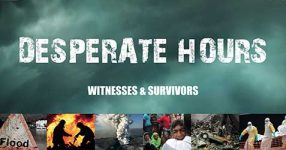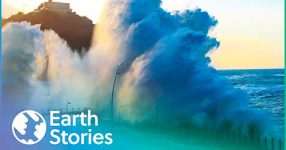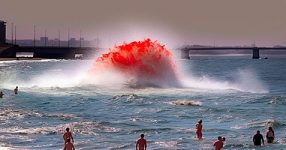The documentary “2015: The Disaster Diaries” delves into the natural disasters of 2015, beginning with Typhoon De Juan’s impact on Taiwan. In September, the cyclone brought a staggering 500 millimeters of rain within 24 hours, equivalent to four months of precipitation. Positioned in the Pacific cyclone path, Taiwan’s government, accustomed to such threats, issued warnings and evacuated vulnerable areas. Cyclone specialist Fabry Chauvin from Meteo France explains the link between cyclones and sea level rise, emphasizing the role of abnormally warm surface sea temperatures in intensifying North Pacific cyclones.
Moving forward, the film captures the urgency of responding to the crisis, as floodgates of dams were opened to counteract the sudden influx of rainwater. The anomalous sea temperature, a potential consequence of global warming, emerges as a central point of discussion in the broader context of the Earth’s climatic shifts.
Bardarbunga Volcano: Unveiling the Hidden Crater
The narrative then shifts to Iceland, exploring the unusual eruption of the Bardarbunga volcano in 2015. Although concealed beneath ice, scientists managed to map the hidden crater, revealing a colossal collapsed caldera. The eruption, concentrated in one part, formed a large crater with an active magma or lava lake. The documentary features insights from Robert Muir Wood, an earth sciences specialist, discussing the intriguing connection between deglaciation and volcanic activity.
The film underlines the potential risks of volcanic eruptions, showcasing the dynamic nature of Earth’s geological processes. The eruption of Bardarbunga, while causing minimal damage and no casualties, raises awareness about the delicate balance between natural phenomena and human vulnerability.
Sakurajima Volcano: Japan’s Active Threat
The focus then shifts to Japan’s Sakurajima volcano, situated on a peninsula with 4,000 inhabitants. With frequent signs of awakening, the volcano is one of Japan’s most active. The documentary explores the geological processes behind volcanic activity, specifically in subduction zones where continental plates collide. The eruption’s aftermath is vividly depicted, showcasing the impact on houses, forests, rivers, and plains.
Through interviews with locals affected by the eruption, the film highlights the unpredictability of natural disasters and the challenges faced by communities living in the proximity of active volcanic zones. The volcanic activity becomes a poignant example of the delicate coexistence between humans and the forces of nature.
Hurricane Patricia and El Nino’s Influence
The documentary then addresses the role of El Nino in exacerbating natural disasters, leading to events like Hurricane Patricia in 2015. Climatologist Eric Gilliardi explains the abnormal rise in Pacific Ocean surface temperatures, a key factor contributing to Hurricane Patricia’s intensity. Despite authorities’ preparedness, only a fraction of the population was evacuated, showcasing the difficulties in managing large-scale evacuations.
The film raises questions about the economic evaluation of natural disasters globally, emphasizing the disproportionate impact on different regions. It further explores how El Nino, a recurring weather phenomenon, influences extreme climatic events worldwide.
Vanuatu’s Devastating Cyclone Pam
The focus then shifts to the devastating Cyclone Pam in Vanuatu, an archipelago known for its paradisiacal islands. The documentary unfolds the tragic events of March 2015, when Cyclone Pam struck, causing widespread destruction. The film captures the resilience of the islanders, detailing efforts to provide aid, rebuild, and address the immediate health concerns of the affected population.
Through interviews with locals and aid workers, the film sheds light on the aftermath of natural disasters, emphasizing the need for global awareness and preparedness. The juxtaposition of Vanuatu’s usual idyllic state with the ravages of Cyclone Pam serves as a stark reminder of the vulnerability of even the most picturesque environments.
California’s Drought and Intense Forest Fires
The documentary then transitions to California, where a prolonged period of drought sets the stage for intense forest fires in 2015. The film captures the scorched landscapes, dwindling water levels, and the combination of factors contributing to epic forest fires. Scientific insights are provided regarding the complex interplay of various environmental factors leading to spontaneous fires.
The film concludes with a discussion on the global implications of climate change, emphasizing the need for collective action to mitigate its effects. The devastating impact on California, marked by extensive forest fires, serves as a cautionary tale, urging viewers to consider the broader consequences of environmental shifts.
Nepal Earthquake: Unpredictable Catastrophe
The narrative then turns to Nepal, exploring the devastating earthquake of 2015. Geologist experts discuss the challenges in predicting earthquakes compared to volcanic eruptions. The film underscores the socio-economic impact of earthquakes, particularly in vulnerable regions with inadequate infrastructure and limited resources.
Through interviews with locals, the film provides a firsthand account of the earthquake’s immediate aftermath and the subsequent struggles for recovery. The contrast between urban and rural areas highlights the disparities in resilience and adaptive capacities, emphasizing the need for comprehensive disaster preparedness and infrastructure development.
El Nino’s Global Impact and Future Scenarios
The documentary concludes by examining the global impact of El Nino and its potential consequences. Climatologists and experts discuss the far-reaching effects of El Nino on climate patterns, emphasizing the need for proactive measures to address the challenges posed by such weather phenomena. The film addresses the ongoing debate on global warming and advocates for political decisions to limit greenhouse gas emissions.
As the film, “2015: The Disaster Diaries” draws to a close, it leaves viewers contemplating the fragile balance between human activities and the Earth’s intricate ecosystems. The juxtaposition of diverse natural disasters in 2015 serves as a compelling narrative to promote awareness, preparedness, and collective action in the face of an unpredictable and evolving climate.












